A teakwood ketch and a devotee’s determination help bring Lord Krsna’s message to the Hawaiian Islands.
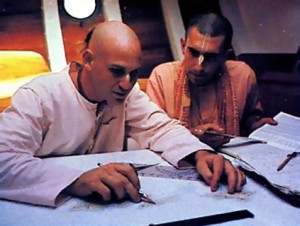 “I like all religions,” Henry said as he drove along, “except the Hare Krsnas.” Narahari was quiet. The two of them had recently met and were now on their way to Henry’s home on a small island off the coast of California. Henry, a big, friendly man in his mid fifties, had a beautiful 53-foot teakwood ketch that he wanted to donate to a worthy charitable organization. He’d been intrigued by an ad in a sailing magazine: “ISKCON, a nonprofit, charitable organization, needs a boat to reach needy people in remote parts of the world.” Henry had no idea that ISKCON stood for the International Society for Krishna Consciousness or that Narahari, the Society’s likable representative sitting next to him, had been a devotee of Krsna for eight years and was president of the Krsna temple in Honolulu.
“I like all religions,” Henry said as he drove along, “except the Hare Krsnas.” Narahari was quiet. The two of them had recently met and were now on their way to Henry’s home on a small island off the coast of California. Henry, a big, friendly man in his mid fifties, had a beautiful 53-foot teakwood ketch that he wanted to donate to a worthy charitable organization. He’d been intrigued by an ad in a sailing magazine: “ISKCON, a nonprofit, charitable organization, needs a boat to reach needy people in remote parts of the world.” Henry had no idea that ISKCON stood for the International Society for Krishna Consciousness or that Narahari, the Society’s likable representative sitting next to him, had been a devotee of Krsna for eight years and was president of the Krsna temple in Honolulu.
Before even meeting Henry, Narahari half-expected that he would have acquired a bad impression of “the Hare Krsnas.” Inaccurate press coverage combined with some mistakes devotees had made in public relations had left many people with a bad impression. But Narahari was confident that Henry’s opinion would change if he heard about Krsna without bias. And now, as Henry was cautiously deciding among several charitable groups interested in his $200,000 ketch, he was curious to learn what “ISKCON” was all about.
“We believe,” Narahari explained as they drove down the scenic highway, “that among all species of life humans are unique in that they alone have the intelligence to inquire into the purpose of life.”
“So, what is that purpose?” Henry asked, both surprised and amused at Narahari’s profundity.
“To become self-realized,” Narahari replied with thoughtful conviction. “To understand that this body we have is like a dress covering our real self—the soul within the body. Just as we wear some clothes for a while and then discard them when they’re old, our soul is covered by the perishable body until the time of death, when the soul leaves the body. After leaving one body the soul enters another, just as after discarding one shirt we put on another.”
Later, seated comfortably in Henry’s warm, rustic living room, Narahari accepted a cup of warm milk graciously offered by Henry’s wife. Henry was contemplating what Narahari had said in the car. Now that his children had their own families an were living away from his secluded home, he was accustomed to passing quiet evenings reading his favorite novels or watching TV. Serious philosophical talk was a refreshing change. Rarely did his friends or relatives venture into such probing topics.
Narahari next explained how the nature of the soul is service, how each living being consciously or unconsciously renders service to another : The trees serve by providing fruits, flowers, wood and shade; the cows serve by providing milk; parents serve their children; businessmen, their customers; and so on. He explained that all these services are temporary. At most they last until death. But the soul within the body is eternal, and the soul’s desire to serve is also eternal. That desire can be fully gratified only when we serve the Supreme Soul, or God.
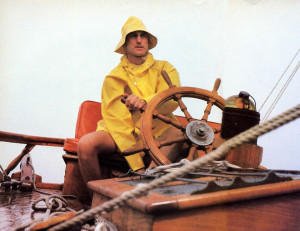
Narahari explained how ISKCON works to help people who are lost in life because they do not know their spiritual identity. “Our greatest need is to understand who we are, who God is, and what our relationship with Him is. If a man has everything money can buy but he lacks this knowledge, he will feel himself unfulfilled.” Narahari sipped his milk and recalled an analogy he had often heard from Srila Prabhupada, his spiritual master. “Just as when my hand supplies this milk to my stomach the hand feeds itself and nourishes all the limbs of my body, so by pleasing God we become pleased and we please others. In ISKCON we have practical experience that the pleasure of serving God is greater than any mundane pleasure.”
Most of the other charities Henry had encountered aimed at helping the needy with food, shelter, clothing, or medical care. A few of them trained people to cultivate land and treat their ailments so they could help themselves. But ISKCON was different. It was distributing God’s instructions; His holy name. His service, His food, His happiness—in short, love of God, a treasure for this lifetime and beyond.
But why did ISKCON need a boat?
“The founders of this movement wanted to distribute love of God to every town and village in the world,” Narahari said. “In other areas our members go by foot, car, train, bus, and in India by bullock cart. But in the Hawaiian Islands the most practical way to travel is by boat. Not by motorboat, since fuel is short, but by sailboat. We can dock at remote ports, conduct seminars, hold festivals, present educational programs, and in that way introduce this very ancient science of God consciousness to people who would otherwise never hear of it.”
It was growing late now, and after talking for a few more minutes, Narahari finished his milk and excused himself to Henry’s guest room. He felt tired from his recent journey but happy that Henry was proving receptive to the mission of ISKCON.

In the days that followed, Narahari and Henry toured the island together, photographed its wildlife, examined Henry’s boat (it was the nicest Narahari had ever seen), and continued discussing the philosophy and activities of ISKCON. Henry liked what he heard, and he liked Narahari. Finally, Henry and his wife decided to give ISKCON not only the boat but also a ten-thousand-dollar donation to make it shipshape!
Henry and Narahari arranged to meet again in two weeks to sign the papers for the donation. Narahari returned to Honolulu and his regular morning schedule: rising before 2 a.m. to chant the Hare Krsna mantra, study the scriptures, and attend the devotional programs in the temple. He also resumed his managerial duties, including his pet projects: importing and grafting the world’s best fruit-bearing and flower-bearing trees and caring for twenty-five beehives. (A graduate of the University of Maryland, Narahari had maintained a longstanding interest in the natural sciences.) After six weeks, though, with no word from Henry, Narahari began to wonder if he’d changed his mind about the boat.
Finally Henry set a date for their second meeting, and Narahari returned to the coastal island at the appointed time. They had a warm reunion, but this time when the subject of religion came up. Henry turned to Narahari and said in a very neutral way, “You’re a Hare Krsna, aren’t you.” Narahari had to admit that he was. “That’s all right,” Henry said meditatively. “If you’d told me in the beginning, I never would have listened to what you had to say. I’d been deceived by the propaganda against you. I’ve learned a lot—I think you’re good people and you’re doing a good thing. I may not understand everything yet, but I know you and I’ve come to like you.”
The two of them worked together to repair the boat. Then Henry transferred the title to ISKCON, and Narahari picked four hardy devotees to sail it to Hawaii with him.
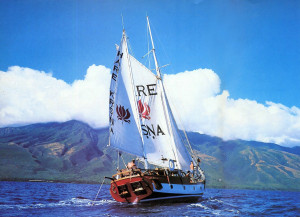
Months earlier, when Narahari had first realized that Hawaii ISKCON needed a boat to expand its mission, he’d taken a four-month course in ocean sailing and celestial navigation at the University of Hawaii. (He’d been boating since he was five, but in the relatively calm waters of Chesapeake Bay near Baltimore, not on the high seas.) Now he and the others who were also new to ocean sailing, embarked on an eighteen-day voyage across the Pacific Ocean. Waves twenty and thirty feet high sometimes dwarfed the boat, thrashing its decks and turning it into a roller-coaster. But Narahari, drawing on every bit of his schooling, kept the boat sailing safely and navigated with pinpoint accuracy, using the sun as a guide.
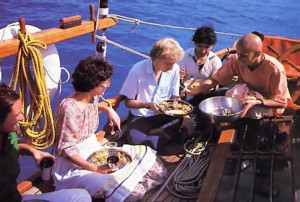
Narahari’s shifts at the helm were in the early morning before daybreak and again at dusk, and when the ocean was calm he reflected on Henry’s generous donation. Feeling deeply grateful, he redoubled his determination to use the boat fully for spreading Krsna consciousness. He planned how he and the other devotees would transform the aft cabin into an authentic Krsna temple, complete with an altar. There the devotees could hold classes in the Bhagavad-gita and Srimad-Bhagvatam and have chanting of Hare Krsna. The fore cabin would serve as the library, study room, kitchen, and, at night, living quarters. On deck, guests could enjoy Hawaii’s clear skies, open seas, and breathtaking views of tropical coastline while hearing discussions about Lord Krsna, the supreme creator of the unequaled panorama.
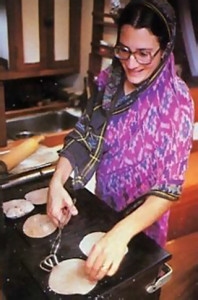
One particular morning, as the stars receded in the brightening dawn sky, an analogy from the Vedas vividly struck Narahari: The entire material world is a vast ocean, an ocean of birth and death. and the human form of life is a sturdy boat, a vessel suitable for crossing the dangerous ocean. The bona fide spiritual master is the ship’s captain, and the instructions of the scriptures are favorable breezes. One who crosses the ocean of birth and death can go back home, back to Godhead, and need never return to this material world. Narahari felt most fortunate to be gradually crossing that ocean.
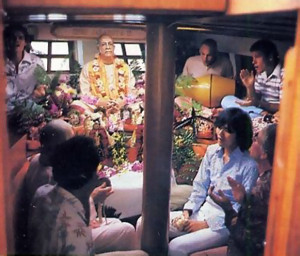
At the journey’s end in the Honolulu harbor, the five devotee-sailors received a warm reception from more than a hundred devotees from the local temple. Newspaper, magazine, and television reporters covered the event. The Honolulu Star-Bulletin reported that the devotees “plan to sail from island to island, dispensing the Vedic culture through music, art, philosophy, and the distribution of sumptuous feasts of a delicious vegetarian cuisine. . . . The transformed temple boat will be one of a kind in the Western Hemisphere. . . . They christened the boat Sri Jaladuta II, after the Indian steamship Jaladuta that carried ISKCON’s founder, A.C. Bhaktivedanta Swami Prabhupada, from Bombay [sic] to Boston in 1965.”
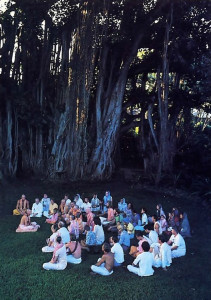
While some devotees will travel on the Sri Jaladuta II staging Hare Krsna festivals, others will continue expanding the temple in Honolulu. “These festival programs,” Narahari said, “along with our Honolulu temple, are meant to give everyone an opportunity to serve the Lord in association with the Lord’s devotees. Srila Prabhupada explained that just as materialistic persons form various clubs and associations to enhance their endeavors, we also have our festivals and centers to invite people—without discrimination as to caste, creed, or color—to have the company of devotees and to hear about Krsna. One who hears receptively will become enthusiastic to progress in spiritual life. If one accepts this opportunity, the path back home, back to Godhead, immediately opens.
“This process of Krsna consciousness isn’t confining for the soul. The soul is inherently free and joyful, but that free joyful nature is covered when one is in material consciousness—in other words, when one forgets Krsna and His service. But when a person comes to the spiritual platform, he sees that everything is coming from Krsna and that Krsna is in everything, and he uses whatever he has in Krsna’s service. Krsna consciousness is not idle meditation but practical action in spiritual life. Although the devotees’ activities may seem like ordinary, mundane chores, they’re not; they’re actually transcendental, because they’re done for the pleasure of Krsna.”
Since coming to Hawaii in 1970, Krsna consciousness has attracted a sizable congregation. One member is Dr. Joseph Mueller, who commented, “When you’ve thrown all the parties you want to throw and you’ve bought all the things you want to buy and you’ve impressed all the people you want to impress, one day you have to sit down and ask yourself. What’s it all for? Is this what life is all about? Then you’re bound to take a spiritual look at life. Otherwise, life becomes just a bad, meaningless joke.
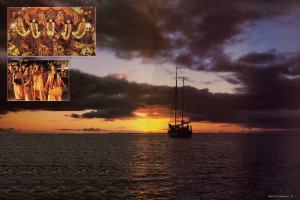
“In the temple, I’ve found a spiritual home. Devotees are eager to talk about God and religion. Krsna consciousness is the only established religion I know of that openly respects all other bonafide religions. My wife and I chant Hare Krsna and read Srila Prabhupada’s books daily. It’s added a dimension to my life that I feel is essential. “
Narahari’s next project is a farming community. He’s already chosen the land : one hundred acres, laced with four year-round natural streams, on Hawaii Island. “It will be a spiritual paradise, ” Narahari says, ” with devotees fully engaged in Krsna’s service, supplied with an abundance of fresh milk from our own cows, as well as with fruits, flowers, vegetables, and grains for offering to the Lord and distributing on a wide scale.
“These three dynamic preaching programs—the boat, the temple, and the new farm—make us confident that Krsna consciousness will continue to blossom in Hawaii—especially since the atmosphere here is conducive to spiritual life. The climate is reminiscent of the spiritual world, and the natural beauty and opulence of the land help us remember Krsna, the source of all beauty and opulence. We want to show practically what Srila Prabhupada told us , that ‘peace of mind, tranquility, and friendly relations between men are possible when Krsna is in center.”


Leave a Reply